Comprehensive Business Plan: Joinery and Carpentry Start-up
VerifiedAdded on 2023/06/12
|10
|2480
|441
AI Summary
This document presents a comprehensive business plan for a joinery and carpentry venture specializing in personalized items, targeting both B2B and B2C markets. The plan outlines the company's mission, vision, and objectives, emphasizing customer engagement through customized designs and high-quality materials. It includes a detailed marketing plan focused on social media promotion and local awareness, an operational plan ensuring skilled labor and efficient resource procurement, and a financial plan projecting costs and revenue streams. The plan also addresses intellectual property rights and incorporates a thorough literature review, including PESTLE and Porter's Five Forces analyses, to assess industry feasibility and competitive dynamics, concluding that the venture is viable with a focus on specialization and strategic adaptation to market forces.
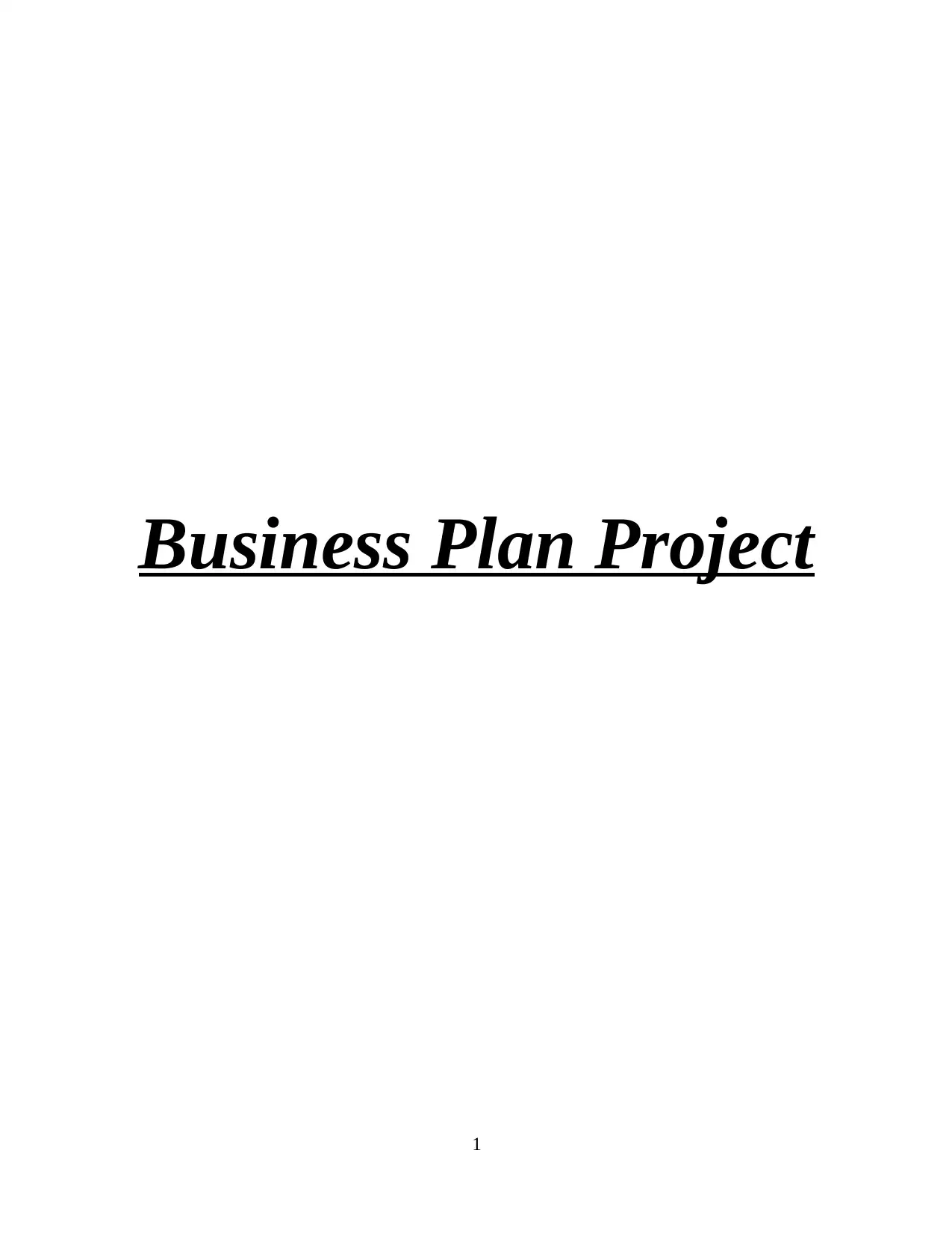
Business Plan Project
1
1
Paraphrase This Document
Need a fresh take? Get an instant paraphrase of this document with our AI Paraphraser
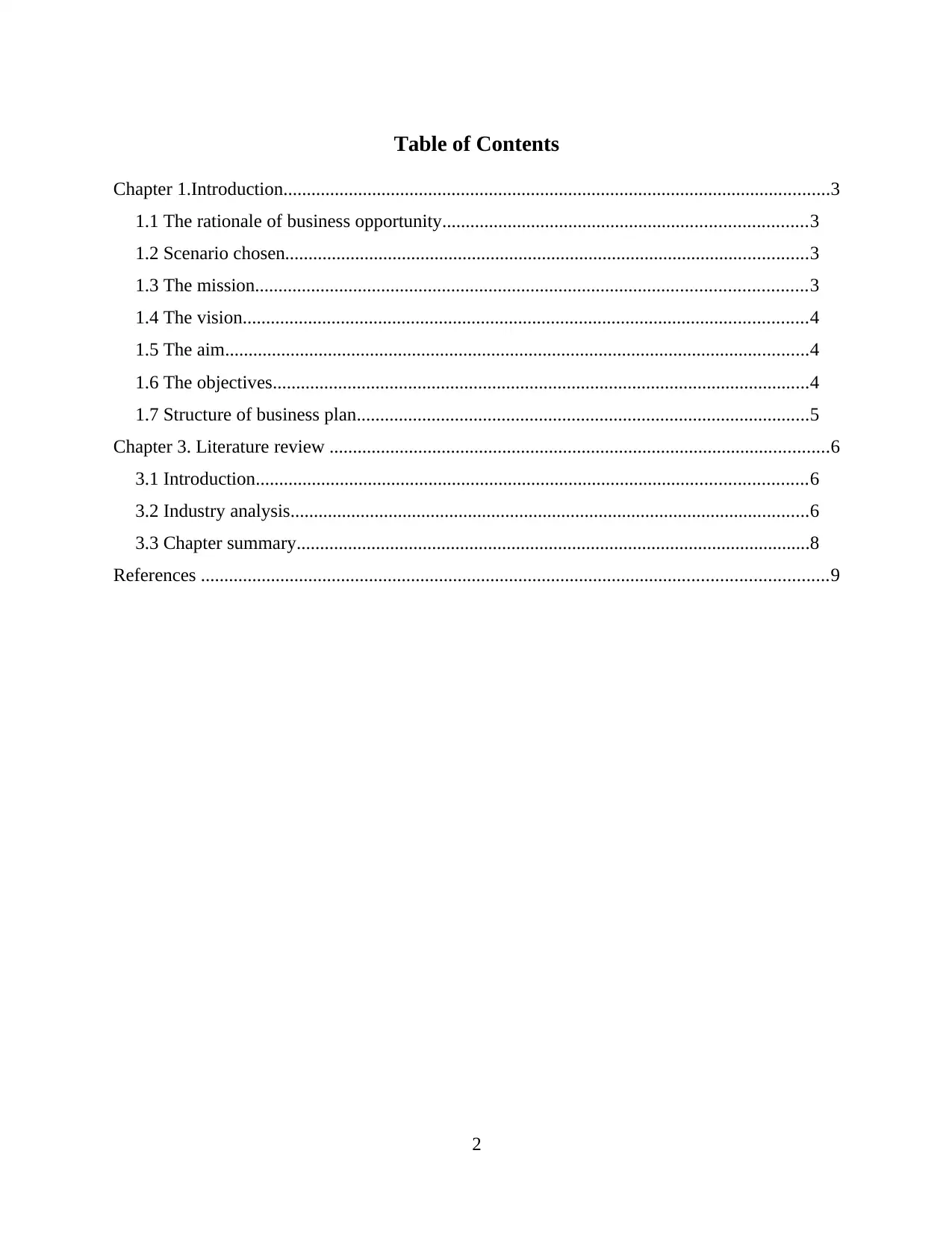
Table of Contents
Chapter 1.Introduction.....................................................................................................................3
1.1 The rationale of business opportunity..............................................................................3
1.2 Scenario chosen................................................................................................................3
1.3 The mission......................................................................................................................3
1.4 The vision.........................................................................................................................4
1.5 The aim.............................................................................................................................4
1.6 The objectives...................................................................................................................4
1.7 Structure of business plan.................................................................................................5
Chapter 3. Literature review ...........................................................................................................6
3.1 Introduction......................................................................................................................6
3.2 Industry analysis...............................................................................................................6
3.3 Chapter summary..............................................................................................................8
References ......................................................................................................................................9
2
Chapter 1.Introduction.....................................................................................................................3
1.1 The rationale of business opportunity..............................................................................3
1.2 Scenario chosen................................................................................................................3
1.3 The mission......................................................................................................................3
1.4 The vision.........................................................................................................................4
1.5 The aim.............................................................................................................................4
1.6 The objectives...................................................................................................................4
1.7 Structure of business plan.................................................................................................5
Chapter 3. Literature review ...........................................................................................................6
3.1 Introduction......................................................................................................................6
3.2 Industry analysis...............................................................................................................6
3.3 Chapter summary..............................................................................................................8
References ......................................................................................................................................9
2
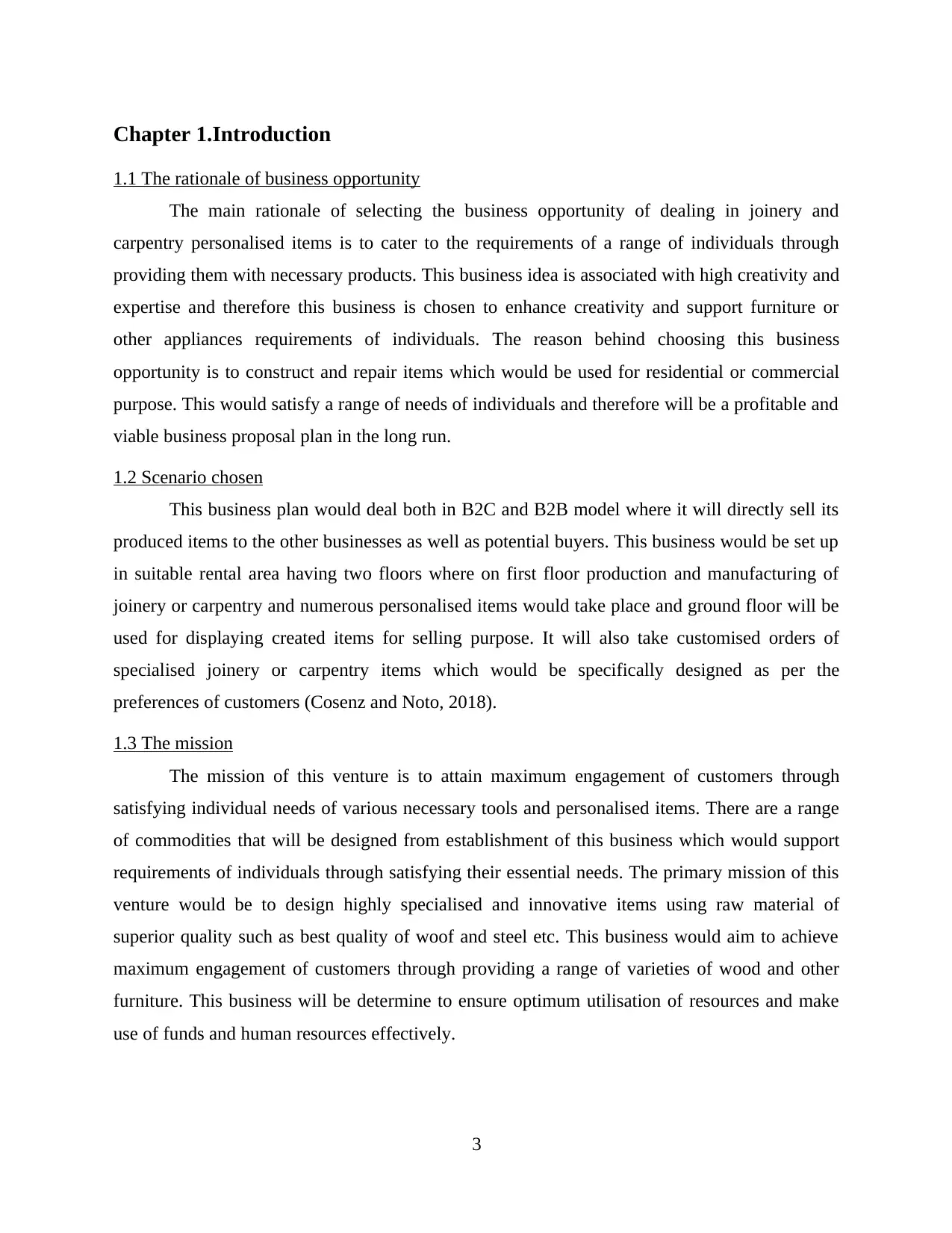
Chapter 1.Introduction
1.1 The rationale of business opportunity
The main rationale of selecting the business opportunity of dealing in joinery and
carpentry personalised items is to cater to the requirements of a range of individuals through
providing them with necessary products. This business idea is associated with high creativity and
expertise and therefore this business is chosen to enhance creativity and support furniture or
other appliances requirements of individuals. The reason behind choosing this business
opportunity is to construct and repair items which would be used for residential or commercial
purpose. This would satisfy a range of needs of individuals and therefore will be a profitable and
viable business proposal plan in the long run.
1.2 Scenario chosen
This business plan would deal both in B2C and B2B model where it will directly sell its
produced items to the other businesses as well as potential buyers. This business would be set up
in suitable rental area having two floors where on first floor production and manufacturing of
joinery or carpentry and numerous personalised items would take place and ground floor will be
used for displaying created items for selling purpose. It will also take customised orders of
specialised joinery or carpentry items which would be specifically designed as per the
preferences of customers (Cosenz and Noto, 2018).
1.3 The mission
The mission of this venture is to attain maximum engagement of customers through
satisfying individual needs of various necessary tools and personalised items. There are a range
of commodities that will be designed from establishment of this business which would support
requirements of individuals through satisfying their essential needs. The primary mission of this
venture would be to design highly specialised and innovative items using raw material of
superior quality such as best quality of woof and steel etc. This business would aim to achieve
maximum engagement of customers through providing a range of varieties of wood and other
furniture. This business will be determine to ensure optimum utilisation of resources and make
use of funds and human resources effectively.
3
1.1 The rationale of business opportunity
The main rationale of selecting the business opportunity of dealing in joinery and
carpentry personalised items is to cater to the requirements of a range of individuals through
providing them with necessary products. This business idea is associated with high creativity and
expertise and therefore this business is chosen to enhance creativity and support furniture or
other appliances requirements of individuals. The reason behind choosing this business
opportunity is to construct and repair items which would be used for residential or commercial
purpose. This would satisfy a range of needs of individuals and therefore will be a profitable and
viable business proposal plan in the long run.
1.2 Scenario chosen
This business plan would deal both in B2C and B2B model where it will directly sell its
produced items to the other businesses as well as potential buyers. This business would be set up
in suitable rental area having two floors where on first floor production and manufacturing of
joinery or carpentry and numerous personalised items would take place and ground floor will be
used for displaying created items for selling purpose. It will also take customised orders of
specialised joinery or carpentry items which would be specifically designed as per the
preferences of customers (Cosenz and Noto, 2018).
1.3 The mission
The mission of this venture is to attain maximum engagement of customers through
satisfying individual needs of various necessary tools and personalised items. There are a range
of commodities that will be designed from establishment of this business which would support
requirements of individuals through satisfying their essential needs. The primary mission of this
venture would be to design highly specialised and innovative items using raw material of
superior quality such as best quality of woof and steel etc. This business would aim to achieve
maximum engagement of customers through providing a range of varieties of wood and other
furniture. This business will be determine to ensure optimum utilisation of resources and make
use of funds and human resources effectively.
3
⊘ This is a preview!⊘
Do you want full access?
Subscribe today to unlock all pages.

Trusted by 1+ million students worldwide
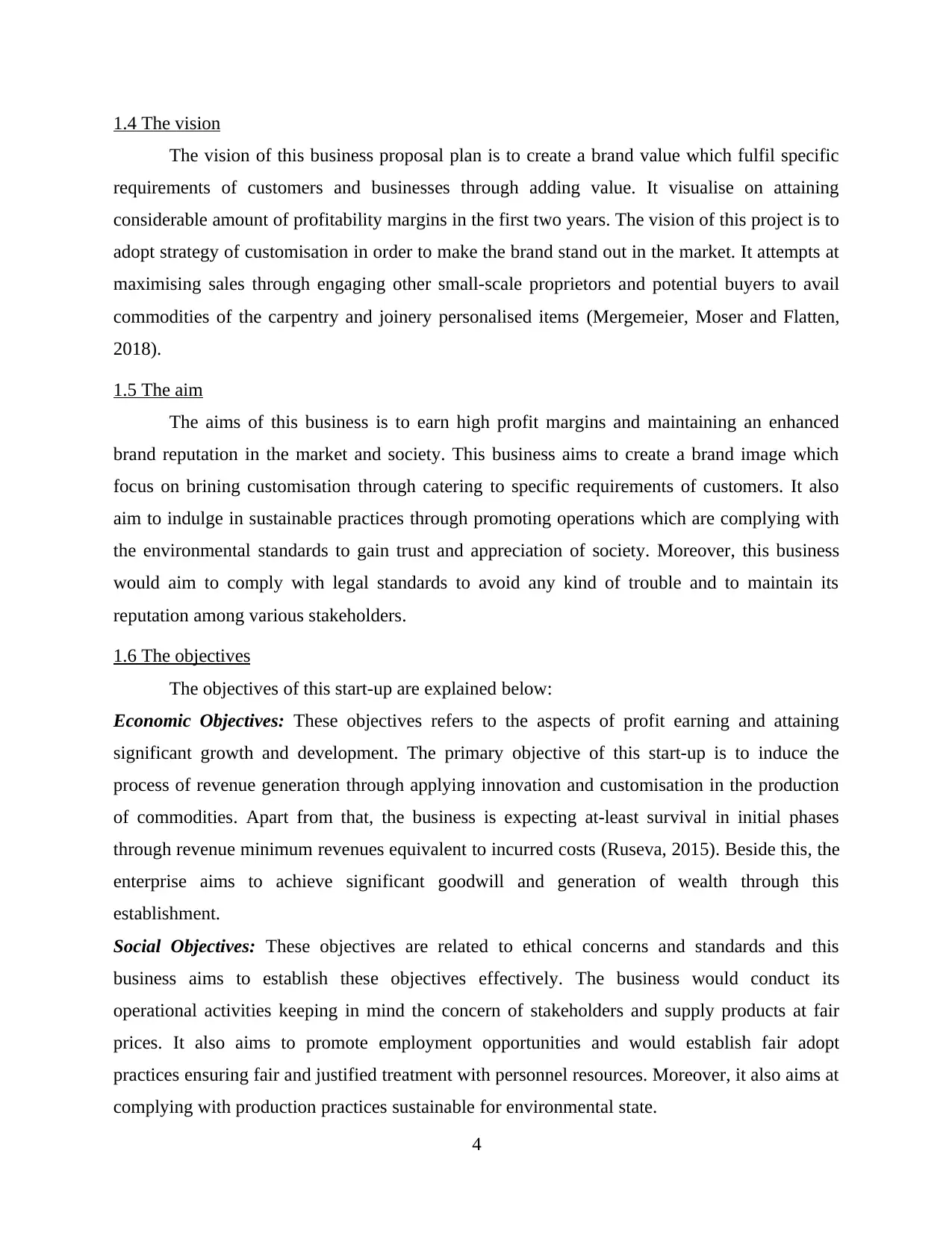
1.4 The vision
The vision of this business proposal plan is to create a brand value which fulfil specific
requirements of customers and businesses through adding value. It visualise on attaining
considerable amount of profitability margins in the first two years. The vision of this project is to
adopt strategy of customisation in order to make the brand stand out in the market. It attempts at
maximising sales through engaging other small-scale proprietors and potential buyers to avail
commodities of the carpentry and joinery personalised items (Mergemeier, Moser and Flatten,
2018).
1.5 The aim
The aims of this business is to earn high profit margins and maintaining an enhanced
brand reputation in the market and society. This business aims to create a brand image which
focus on brining customisation through catering to specific requirements of customers. It also
aim to indulge in sustainable practices through promoting operations which are complying with
the environmental standards to gain trust and appreciation of society. Moreover, this business
would aim to comply with legal standards to avoid any kind of trouble and to maintain its
reputation among various stakeholders.
1.6 The objectives
The objectives of this start-up are explained below:
Economic Objectives: These objectives refers to the aspects of profit earning and attaining
significant growth and development. The primary objective of this start-up is to induce the
process of revenue generation through applying innovation and customisation in the production
of commodities. Apart from that, the business is expecting at-least survival in initial phases
through revenue minimum revenues equivalent to incurred costs (Ruseva, 2015). Beside this, the
enterprise aims to achieve significant goodwill and generation of wealth through this
establishment.
Social Objectives: These objectives are related to ethical concerns and standards and this
business aims to establish these objectives effectively. The business would conduct its
operational activities keeping in mind the concern of stakeholders and supply products at fair
prices. It also aims to promote employment opportunities and would establish fair adopt
practices ensuring fair and justified treatment with personnel resources. Moreover, it also aims at
complying with production practices sustainable for environmental state.
4
The vision of this business proposal plan is to create a brand value which fulfil specific
requirements of customers and businesses through adding value. It visualise on attaining
considerable amount of profitability margins in the first two years. The vision of this project is to
adopt strategy of customisation in order to make the brand stand out in the market. It attempts at
maximising sales through engaging other small-scale proprietors and potential buyers to avail
commodities of the carpentry and joinery personalised items (Mergemeier, Moser and Flatten,
2018).
1.5 The aim
The aims of this business is to earn high profit margins and maintaining an enhanced
brand reputation in the market and society. This business aims to create a brand image which
focus on brining customisation through catering to specific requirements of customers. It also
aim to indulge in sustainable practices through promoting operations which are complying with
the environmental standards to gain trust and appreciation of society. Moreover, this business
would aim to comply with legal standards to avoid any kind of trouble and to maintain its
reputation among various stakeholders.
1.6 The objectives
The objectives of this start-up are explained below:
Economic Objectives: These objectives refers to the aspects of profit earning and attaining
significant growth and development. The primary objective of this start-up is to induce the
process of revenue generation through applying innovation and customisation in the production
of commodities. Apart from that, the business is expecting at-least survival in initial phases
through revenue minimum revenues equivalent to incurred costs (Ruseva, 2015). Beside this, the
enterprise aims to achieve significant goodwill and generation of wealth through this
establishment.
Social Objectives: These objectives are related to ethical concerns and standards and this
business aims to establish these objectives effectively. The business would conduct its
operational activities keeping in mind the concern of stakeholders and supply products at fair
prices. It also aims to promote employment opportunities and would establish fair adopt
practices ensuring fair and justified treatment with personnel resources. Moreover, it also aims at
complying with production practices sustainable for environmental state.
4
Paraphrase This Document
Need a fresh take? Get an instant paraphrase of this document with our AI Paraphraser
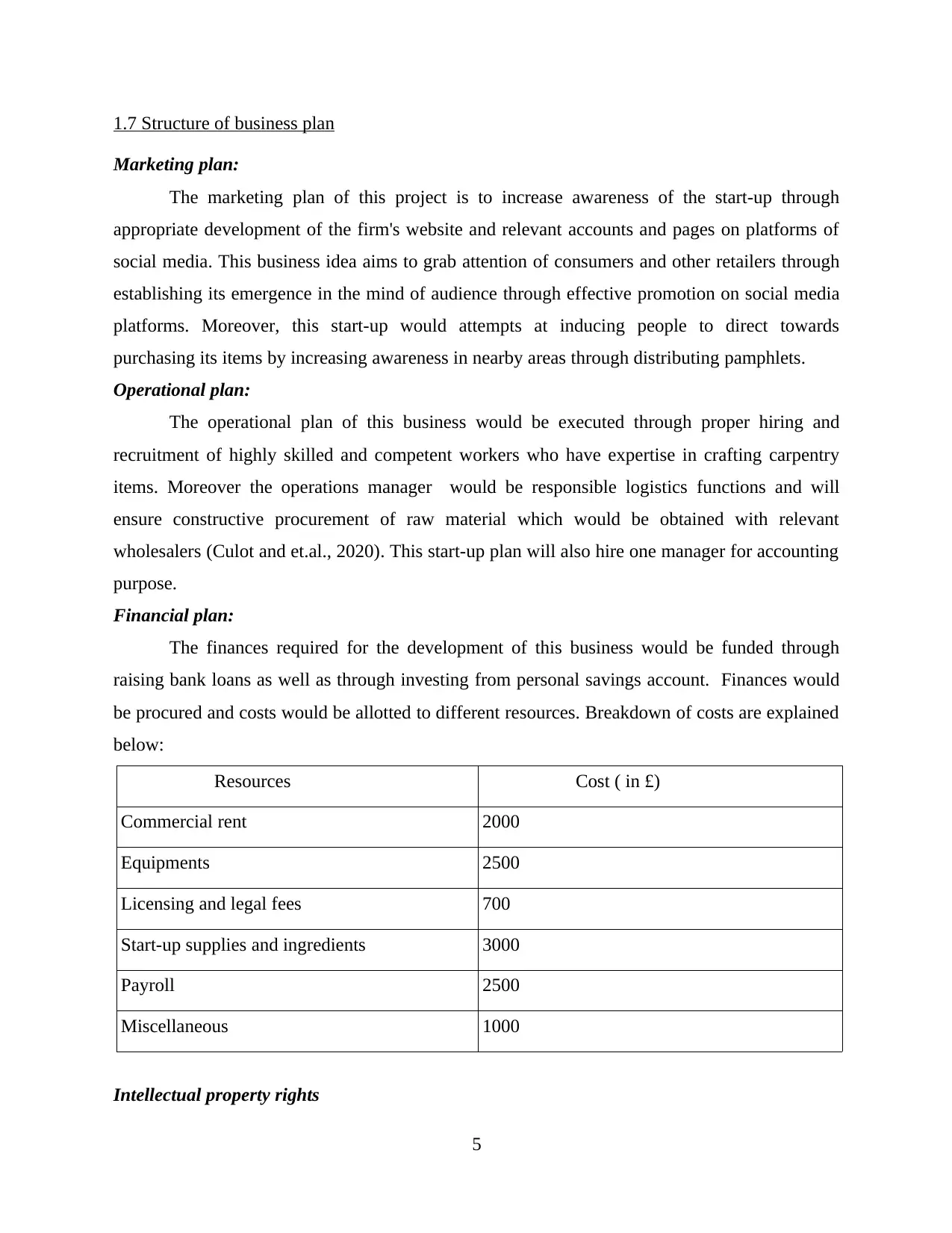
1.7 Structure of business plan
Marketing plan:
The marketing plan of this project is to increase awareness of the start-up through
appropriate development of the firm's website and relevant accounts and pages on platforms of
social media. This business idea aims to grab attention of consumers and other retailers through
establishing its emergence in the mind of audience through effective promotion on social media
platforms. Moreover, this start-up would attempts at inducing people to direct towards
purchasing its items by increasing awareness in nearby areas through distributing pamphlets.
Operational plan:
The operational plan of this business would be executed through proper hiring and
recruitment of highly skilled and competent workers who have expertise in crafting carpentry
items. Moreover the operations manager would be responsible logistics functions and will
ensure constructive procurement of raw material which would be obtained with relevant
wholesalers (Culot and et.al., 2020). This start-up plan will also hire one manager for accounting
purpose.
Financial plan:
The finances required for the development of this business would be funded through
raising bank loans as well as through investing from personal savings account. Finances would
be procured and costs would be allotted to different resources. Breakdown of costs are explained
below:
Resources Cost ( in £)
Commercial rent 2000
Equipments 2500
Licensing and legal fees 700
Start-up supplies and ingredients 3000
Payroll 2500
Miscellaneous 1000
Intellectual property rights
5
Marketing plan:
The marketing plan of this project is to increase awareness of the start-up through
appropriate development of the firm's website and relevant accounts and pages on platforms of
social media. This business idea aims to grab attention of consumers and other retailers through
establishing its emergence in the mind of audience through effective promotion on social media
platforms. Moreover, this start-up would attempts at inducing people to direct towards
purchasing its items by increasing awareness in nearby areas through distributing pamphlets.
Operational plan:
The operational plan of this business would be executed through proper hiring and
recruitment of highly skilled and competent workers who have expertise in crafting carpentry
items. Moreover the operations manager would be responsible logistics functions and will
ensure constructive procurement of raw material which would be obtained with relevant
wholesalers (Culot and et.al., 2020). This start-up plan will also hire one manager for accounting
purpose.
Financial plan:
The finances required for the development of this business would be funded through
raising bank loans as well as through investing from personal savings account. Finances would
be procured and costs would be allotted to different resources. Breakdown of costs are explained
below:
Resources Cost ( in £)
Commercial rent 2000
Equipments 2500
Licensing and legal fees 700
Start-up supplies and ingredients 3000
Payroll 2500
Miscellaneous 1000
Intellectual property rights
5
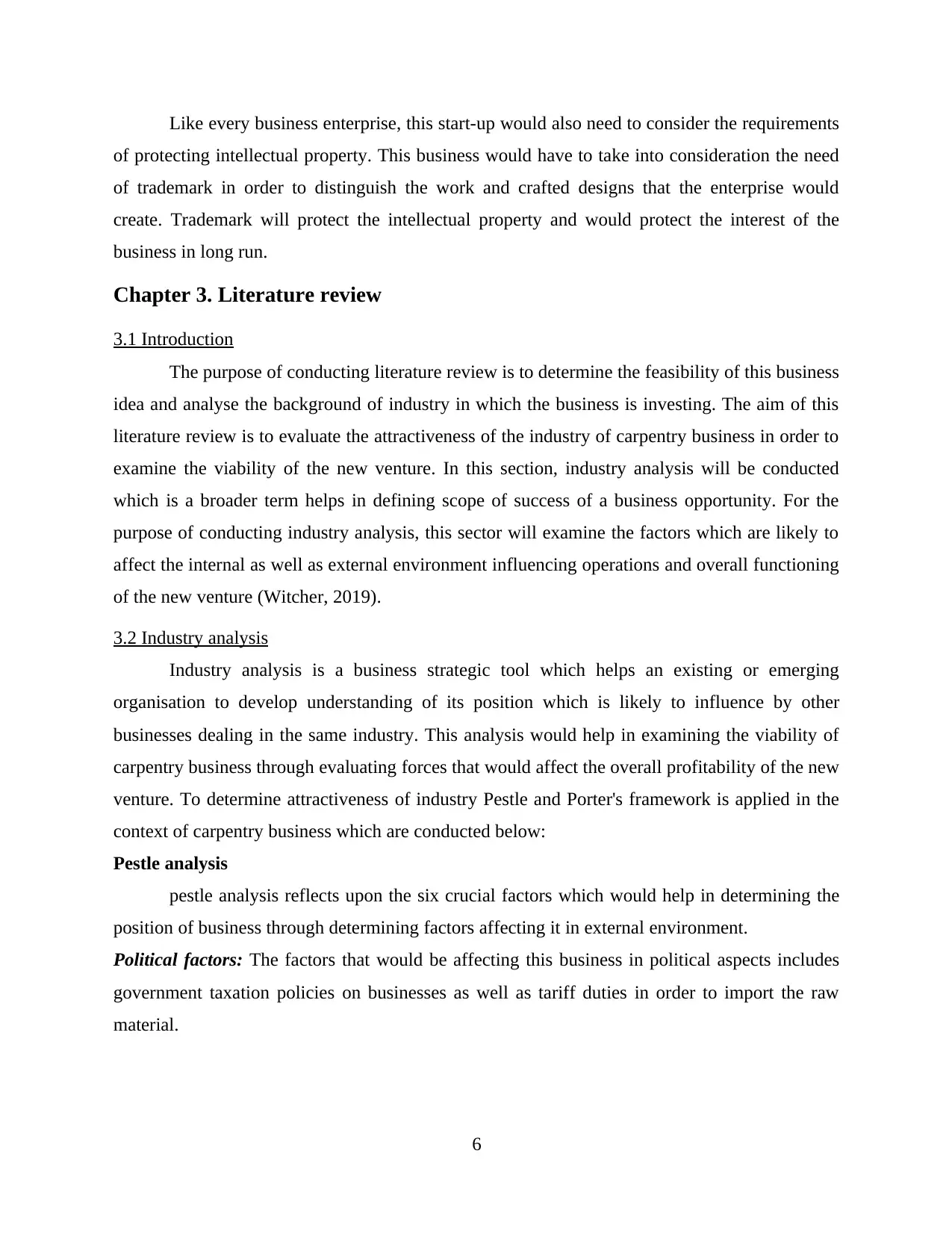
Like every business enterprise, this start-up would also need to consider the requirements
of protecting intellectual property. This business would have to take into consideration the need
of trademark in order to distinguish the work and crafted designs that the enterprise would
create. Trademark will protect the intellectual property and would protect the interest of the
business in long run.
Chapter 3. Literature review
3.1 Introduction
The purpose of conducting literature review is to determine the feasibility of this business
idea and analyse the background of industry in which the business is investing. The aim of this
literature review is to evaluate the attractiveness of the industry of carpentry business in order to
examine the viability of the new venture. In this section, industry analysis will be conducted
which is a broader term helps in defining scope of success of a business opportunity. For the
purpose of conducting industry analysis, this sector will examine the factors which are likely to
affect the internal as well as external environment influencing operations and overall functioning
of the new venture (Witcher, 2019).
3.2 Industry analysis
Industry analysis is a business strategic tool which helps an existing or emerging
organisation to develop understanding of its position which is likely to influence by other
businesses dealing in the same industry. This analysis would help in examining the viability of
carpentry business through evaluating forces that would affect the overall profitability of the new
venture. To determine attractiveness of industry Pestle and Porter's framework is applied in the
context of carpentry business which are conducted below:
Pestle analysis
pestle analysis reflects upon the six crucial factors which would help in determining the
position of business through determining factors affecting it in external environment.
Political factors: The factors that would be affecting this business in political aspects includes
government taxation policies on businesses as well as tariff duties in order to import the raw
material.
6
of protecting intellectual property. This business would have to take into consideration the need
of trademark in order to distinguish the work and crafted designs that the enterprise would
create. Trademark will protect the intellectual property and would protect the interest of the
business in long run.
Chapter 3. Literature review
3.1 Introduction
The purpose of conducting literature review is to determine the feasibility of this business
idea and analyse the background of industry in which the business is investing. The aim of this
literature review is to evaluate the attractiveness of the industry of carpentry business in order to
examine the viability of the new venture. In this section, industry analysis will be conducted
which is a broader term helps in defining scope of success of a business opportunity. For the
purpose of conducting industry analysis, this sector will examine the factors which are likely to
affect the internal as well as external environment influencing operations and overall functioning
of the new venture (Witcher, 2019).
3.2 Industry analysis
Industry analysis is a business strategic tool which helps an existing or emerging
organisation to develop understanding of its position which is likely to influence by other
businesses dealing in the same industry. This analysis would help in examining the viability of
carpentry business through evaluating forces that would affect the overall profitability of the new
venture. To determine attractiveness of industry Pestle and Porter's framework is applied in the
context of carpentry business which are conducted below:
Pestle analysis
pestle analysis reflects upon the six crucial factors which would help in determining the
position of business through determining factors affecting it in external environment.
Political factors: The factors that would be affecting this business in political aspects includes
government taxation policies on businesses as well as tariff duties in order to import the raw
material.
6
⊘ This is a preview!⊘
Do you want full access?
Subscribe today to unlock all pages.

Trusted by 1+ million students worldwide
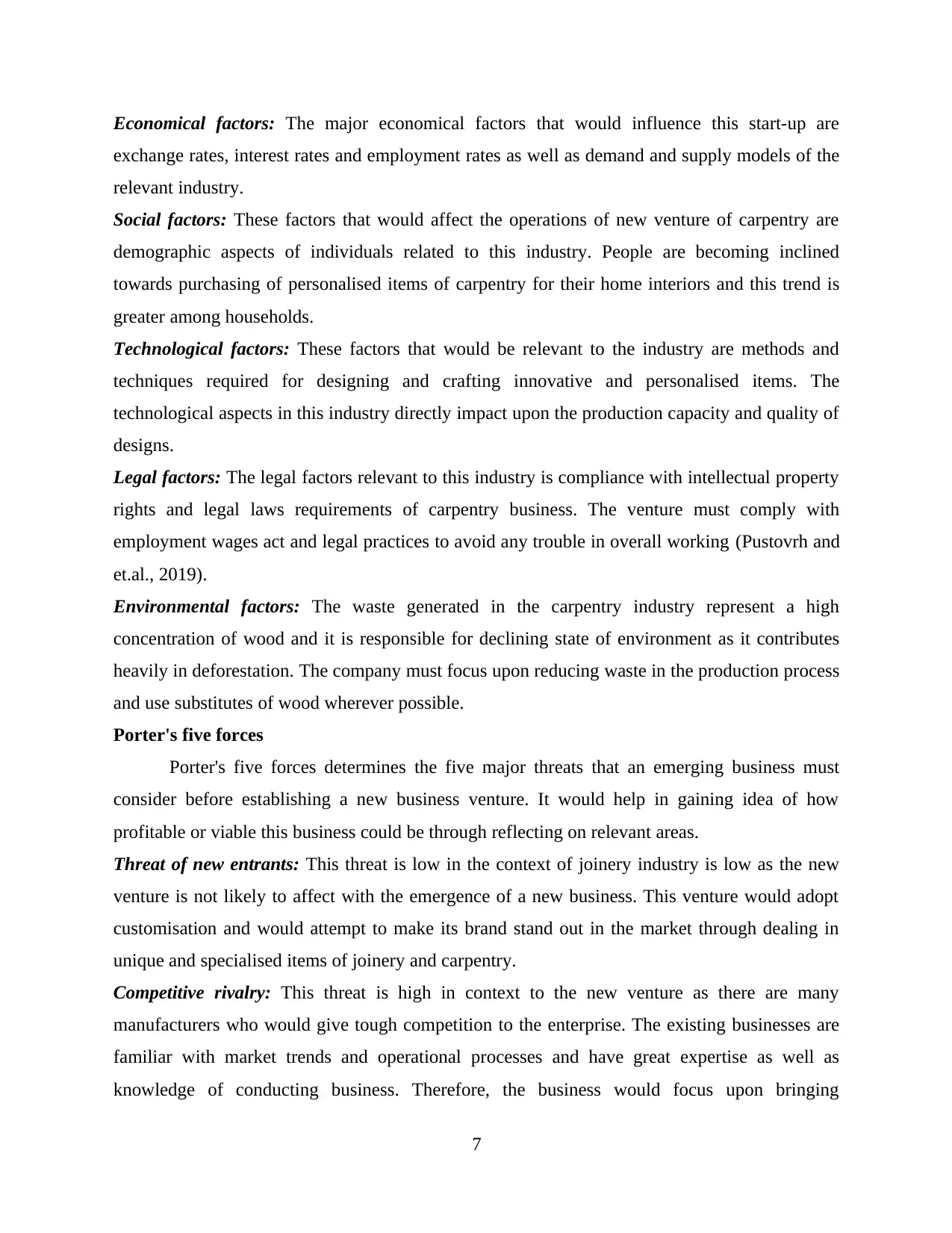
Economical factors: The major economical factors that would influence this start-up are
exchange rates, interest rates and employment rates as well as demand and supply models of the
relevant industry.
Social factors: These factors that would affect the operations of new venture of carpentry are
demographic aspects of individuals related to this industry. People are becoming inclined
towards purchasing of personalised items of carpentry for their home interiors and this trend is
greater among households.
Technological factors: These factors that would be relevant to the industry are methods and
techniques required for designing and crafting innovative and personalised items. The
technological aspects in this industry directly impact upon the production capacity and quality of
designs.
Legal factors: The legal factors relevant to this industry is compliance with intellectual property
rights and legal laws requirements of carpentry business. The venture must comply with
employment wages act and legal practices to avoid any trouble in overall working (Pustovrh and
et.al., 2019).
Environmental factors: The waste generated in the carpentry industry represent a high
concentration of wood and it is responsible for declining state of environment as it contributes
heavily in deforestation. The company must focus upon reducing waste in the production process
and use substitutes of wood wherever possible.
Porter's five forces
Porter's five forces determines the five major threats that an emerging business must
consider before establishing a new business venture. It would help in gaining idea of how
profitable or viable this business could be through reflecting on relevant areas.
Threat of new entrants: This threat is low in the context of joinery industry is low as the new
venture is not likely to affect with the emergence of a new business. This venture would adopt
customisation and would attempt to make its brand stand out in the market through dealing in
unique and specialised items of joinery and carpentry.
Competitive rivalry: This threat is high in context to the new venture as there are many
manufacturers who would give tough competition to the enterprise. The existing businesses are
familiar with market trends and operational processes and have great expertise as well as
knowledge of conducting business. Therefore, the business would focus upon bringing
7
exchange rates, interest rates and employment rates as well as demand and supply models of the
relevant industry.
Social factors: These factors that would affect the operations of new venture of carpentry are
demographic aspects of individuals related to this industry. People are becoming inclined
towards purchasing of personalised items of carpentry for their home interiors and this trend is
greater among households.
Technological factors: These factors that would be relevant to the industry are methods and
techniques required for designing and crafting innovative and personalised items. The
technological aspects in this industry directly impact upon the production capacity and quality of
designs.
Legal factors: The legal factors relevant to this industry is compliance with intellectual property
rights and legal laws requirements of carpentry business. The venture must comply with
employment wages act and legal practices to avoid any trouble in overall working (Pustovrh and
et.al., 2019).
Environmental factors: The waste generated in the carpentry industry represent a high
concentration of wood and it is responsible for declining state of environment as it contributes
heavily in deforestation. The company must focus upon reducing waste in the production process
and use substitutes of wood wherever possible.
Porter's five forces
Porter's five forces determines the five major threats that an emerging business must
consider before establishing a new business venture. It would help in gaining idea of how
profitable or viable this business could be through reflecting on relevant areas.
Threat of new entrants: This threat is low in the context of joinery industry is low as the new
venture is not likely to affect with the emergence of a new business. This venture would adopt
customisation and would attempt to make its brand stand out in the market through dealing in
unique and specialised items of joinery and carpentry.
Competitive rivalry: This threat is high in context to the new venture as there are many
manufacturers who would give tough competition to the enterprise. The existing businesses are
familiar with market trends and operational processes and have great expertise as well as
knowledge of conducting business. Therefore, the business would focus upon bringing
7
Paraphrase This Document
Need a fresh take? Get an instant paraphrase of this document with our AI Paraphraser
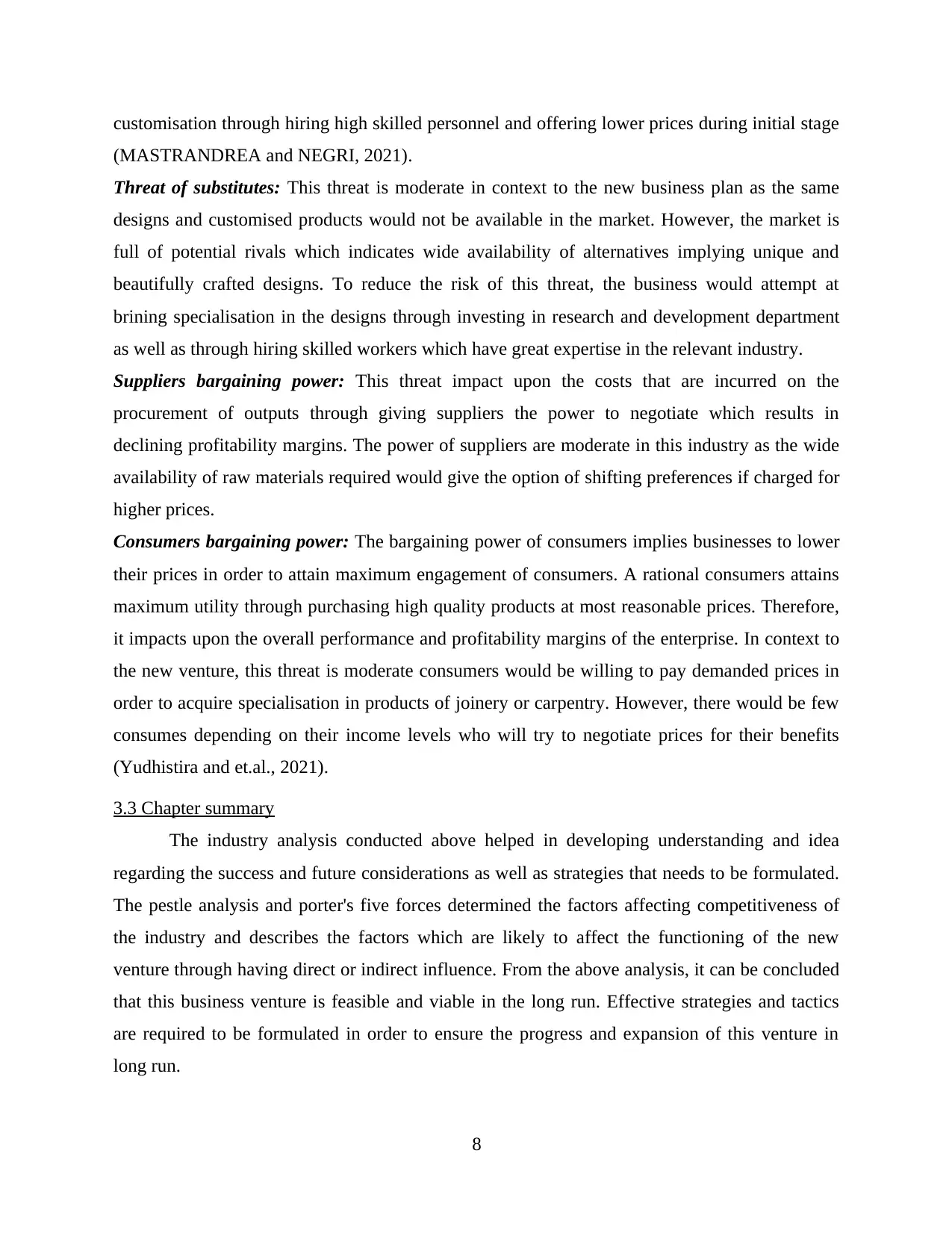
customisation through hiring high skilled personnel and offering lower prices during initial stage
(MASTRANDREA and NEGRI, 2021).
Threat of substitutes: This threat is moderate in context to the new business plan as the same
designs and customised products would not be available in the market. However, the market is
full of potential rivals which indicates wide availability of alternatives implying unique and
beautifully crafted designs. To reduce the risk of this threat, the business would attempt at
brining specialisation in the designs through investing in research and development department
as well as through hiring skilled workers which have great expertise in the relevant industry.
Suppliers bargaining power: This threat impact upon the costs that are incurred on the
procurement of outputs through giving suppliers the power to negotiate which results in
declining profitability margins. The power of suppliers are moderate in this industry as the wide
availability of raw materials required would give the option of shifting preferences if charged for
higher prices.
Consumers bargaining power: The bargaining power of consumers implies businesses to lower
their prices in order to attain maximum engagement of consumers. A rational consumers attains
maximum utility through purchasing high quality products at most reasonable prices. Therefore,
it impacts upon the overall performance and profitability margins of the enterprise. In context to
the new venture, this threat is moderate consumers would be willing to pay demanded prices in
order to acquire specialisation in products of joinery or carpentry. However, there would be few
consumes depending on their income levels who will try to negotiate prices for their benefits
(Yudhistira and et.al., 2021).
3.3 Chapter summary
The industry analysis conducted above helped in developing understanding and idea
regarding the success and future considerations as well as strategies that needs to be formulated.
The pestle analysis and porter's five forces determined the factors affecting competitiveness of
the industry and describes the factors which are likely to affect the functioning of the new
venture through having direct or indirect influence. From the above analysis, it can be concluded
that this business venture is feasible and viable in the long run. Effective strategies and tactics
are required to be formulated in order to ensure the progress and expansion of this venture in
long run.
8
(MASTRANDREA and NEGRI, 2021).
Threat of substitutes: This threat is moderate in context to the new business plan as the same
designs and customised products would not be available in the market. However, the market is
full of potential rivals which indicates wide availability of alternatives implying unique and
beautifully crafted designs. To reduce the risk of this threat, the business would attempt at
brining specialisation in the designs through investing in research and development department
as well as through hiring skilled workers which have great expertise in the relevant industry.
Suppliers bargaining power: This threat impact upon the costs that are incurred on the
procurement of outputs through giving suppliers the power to negotiate which results in
declining profitability margins. The power of suppliers are moderate in this industry as the wide
availability of raw materials required would give the option of shifting preferences if charged for
higher prices.
Consumers bargaining power: The bargaining power of consumers implies businesses to lower
their prices in order to attain maximum engagement of consumers. A rational consumers attains
maximum utility through purchasing high quality products at most reasonable prices. Therefore,
it impacts upon the overall performance and profitability margins of the enterprise. In context to
the new venture, this threat is moderate consumers would be willing to pay demanded prices in
order to acquire specialisation in products of joinery or carpentry. However, there would be few
consumes depending on their income levels who will try to negotiate prices for their benefits
(Yudhistira and et.al., 2021).
3.3 Chapter summary
The industry analysis conducted above helped in developing understanding and idea
regarding the success and future considerations as well as strategies that needs to be formulated.
The pestle analysis and porter's five forces determined the factors affecting competitiveness of
the industry and describes the factors which are likely to affect the functioning of the new
venture through having direct or indirect influence. From the above analysis, it can be concluded
that this business venture is feasible and viable in the long run. Effective strategies and tactics
are required to be formulated in order to ensure the progress and expansion of this venture in
long run.
8

9
⊘ This is a preview!⊘
Do you want full access?
Subscribe today to unlock all pages.

Trusted by 1+ million students worldwide
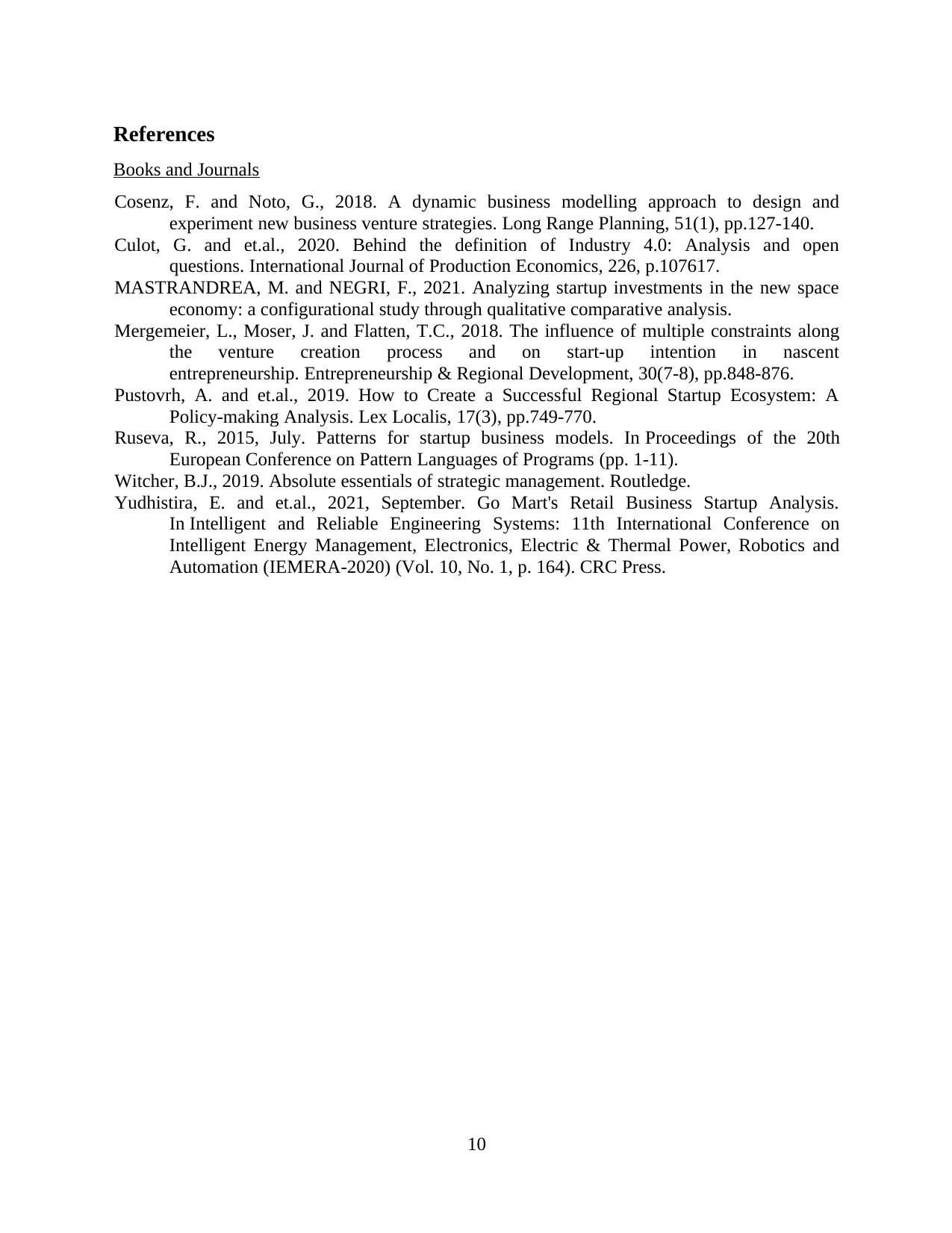
References
Books and Journals
Cosenz, F. and Noto, G., 2018. A dynamic business modelling approach to design and
experiment new business venture strategies. Long Range Planning, 51(1), pp.127-140.
Culot, G. and et.al., 2020. Behind the definition of Industry 4.0: Analysis and open
questions. International Journal of Production Economics, 226, p.107617.
MASTRANDREA, M. and NEGRI, F., 2021. Analyzing startup investments in the new space
economy: a configurational study through qualitative comparative analysis.
Mergemeier, L., Moser, J. and Flatten, T.C., 2018. The influence of multiple constraints along
the venture creation process and on start-up intention in nascent
entrepreneurship. Entrepreneurship & Regional Development, 30(7-8), pp.848-876.
Pustovrh, A. and et.al., 2019. How to Create a Successful Regional Startup Ecosystem: A
Policy-making Analysis. Lex Localis, 17(3), pp.749-770.
Ruseva, R., 2015, July. Patterns for startup business models. In Proceedings of the 20th
European Conference on Pattern Languages of Programs (pp. 1-11).
Witcher, B.J., 2019. Absolute essentials of strategic management. Routledge.
Yudhistira, E. and et.al., 2021, September. Go Mart's Retail Business Startup Analysis.
In Intelligent and Reliable Engineering Systems: 11th International Conference on
Intelligent Energy Management, Electronics, Electric & Thermal Power, Robotics and
Automation (IEMERA-2020) (Vol. 10, No. 1, p. 164). CRC Press.
10
Books and Journals
Cosenz, F. and Noto, G., 2018. A dynamic business modelling approach to design and
experiment new business venture strategies. Long Range Planning, 51(1), pp.127-140.
Culot, G. and et.al., 2020. Behind the definition of Industry 4.0: Analysis and open
questions. International Journal of Production Economics, 226, p.107617.
MASTRANDREA, M. and NEGRI, F., 2021. Analyzing startup investments in the new space
economy: a configurational study through qualitative comparative analysis.
Mergemeier, L., Moser, J. and Flatten, T.C., 2018. The influence of multiple constraints along
the venture creation process and on start-up intention in nascent
entrepreneurship. Entrepreneurship & Regional Development, 30(7-8), pp.848-876.
Pustovrh, A. and et.al., 2019. How to Create a Successful Regional Startup Ecosystem: A
Policy-making Analysis. Lex Localis, 17(3), pp.749-770.
Ruseva, R., 2015, July. Patterns for startup business models. In Proceedings of the 20th
European Conference on Pattern Languages of Programs (pp. 1-11).
Witcher, B.J., 2019. Absolute essentials of strategic management. Routledge.
Yudhistira, E. and et.al., 2021, September. Go Mart's Retail Business Startup Analysis.
In Intelligent and Reliable Engineering Systems: 11th International Conference on
Intelligent Energy Management, Electronics, Electric & Thermal Power, Robotics and
Automation (IEMERA-2020) (Vol. 10, No. 1, p. 164). CRC Press.
10
1 out of 10
Related Documents
Your All-in-One AI-Powered Toolkit for Academic Success.
+13062052269
info@desklib.com
Available 24*7 on WhatsApp / Email
![[object Object]](/_next/static/media/star-bottom.7253800d.svg)
Unlock your academic potential
Copyright © 2020–2025 A2Z Services. All Rights Reserved. Developed and managed by ZUCOL.




